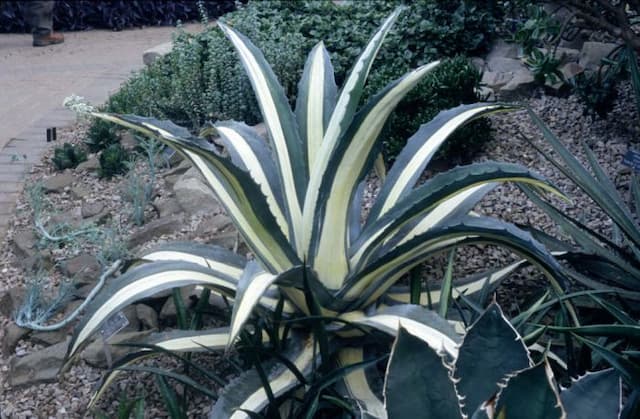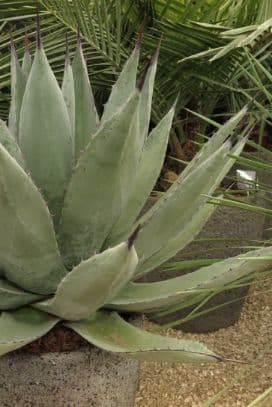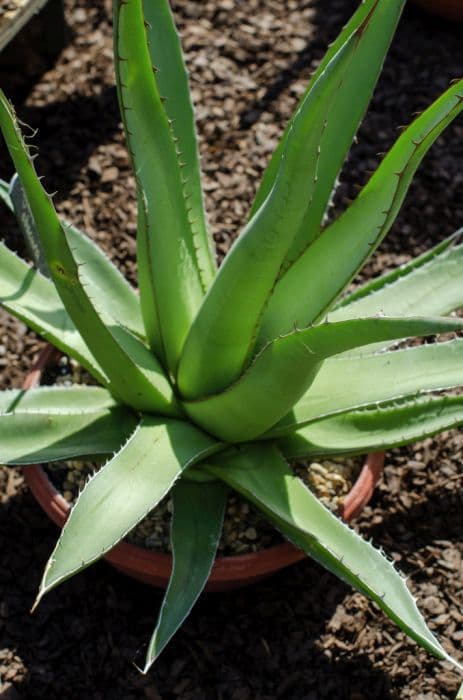Electric Flash Grass Tree Cordyline banksii Electric Flash = 'Sprilecflash' (PBR)

ABOUT
The plant known as Electric Flash is characterized by its striking foliage, which sets it apart from other garden plants. The leaves are the most distinctive feature, presenting a unique combination of colors and patterns. Each leaf is elongated with a sword-like shape, creating a bold, architectural silhouette. The coloration of the leaves is a dynamic contrast of deep burgundy and chartreuse stripes, reminiscent of the vibrant flashes of electricity that inspire its name. The stripes run the length of each leaf, adding a sense of movement and energy to the plant's overall appearance. Along the edges of the leaves, a delicate border of the same dark burgundy adds a refined touch. The leaves form a clustered rosette, emerging from a central point, and gracefully arching outward. This arrangement lends the plant a lush, full look, making it an excellent choice for adding textural contrast to garden landscapes or indoor spaces. The plant's overall shape and leaf arrangement give it a tropical and exotic feel, which can infuse a sense of drama and flair wherever it is placed. The vivid color palette of the Electric Flash ensures that it will be a prominent feature in any setting, captivating onlookers with its bold and electrifying presence.
About this plant
 Names
NamesFamily
Asparagaceae
Synonyms
Electric Flash Cordyline, Electric Flash Grass Tree
Common names
Cordyline banksii Electric Flash = 'Sprilecflash' (PBR)
 Toxicity
ToxicityTo humans
The plant commonly known as Electric Flash is generally not considered toxic to humans. However, like with many ornamental plants, sensitivity can vary from person to person. Ingesting parts of this plant is not advised, as it may cause mild stomach upset or an allergic reaction. There is no significant toxicity that would lead to severe poisoning.
To pets
Electric Flash is not known to be toxic to pets. However, it is always a good practice to prevent pets from ingesting plants, as they could potentially cause gastric irritation or an allergic reaction in sensitive animals. If a pet does ingest some part of the plant, it is unlikely to be seriously harmful, but monitoring for any signs of discomfort is recommended.
 Characteristics
CharacteristicsLife cycle
Perennials
Foliage type
Evergreen
Color of leaves
Mixed
Height
3-5 feet (0.9-1.5 meters)
Spread
2-3 feet (0.6-0.9 meters)
Plant type
Shrub
Hardiness zones
9
Native area
New Zealand
Benefits
 General Benefits
General Benefits- Low Maintenance: Requires minimal care once established, making it ideal for busy gardeners.
- Drought Tolerant: Can survive in dry conditions, reducing the need for frequent watering.
- Attractive Foliage: Features striking, variegated leaves that add visual interest to any garden setting.
- Compact Size: Grows to a manageable size that's suitable for small gardens or container planting.
- Hardy: Able to withstand a range of weather conditions, including cooler temperatures.
- Accent Plant: Works well as a focal point in landscaping, providing a burst of color and texture.
- Versatile: Can be used in a variety of garden styles, including tropical, modern, and Mediterranean themes.
- Easy Propagation: Can be easily propagated from stem cuttings, allowing gardeners to create more plants.
- Evergreen: Retains its foliage year-round, ensuring continuous garden interest.
 Medical Properties
Medical PropertiesThis plant is not used for medical purposes.
 Air-purifying Qualities
Air-purifying QualitiesThis plant is not specifically known for air purifying qualities.
 Other Uses
Other Uses- Textile Dyeing: The vividly colored leaves of Cordyline banksii can be used to extract natural dyes for textile arts, providing hues ranging from greens to purples depending on the mordant used.
- Themed Events Decoration: Because of its striking appearance, Cordyline banksii can be used to create dramatic displays at sci-fi or fantasy-themed events.
- Visual Barrier: The dense growth habit of this plant makes it ideal for creating visual barriers in gardens or on patios.
- Photography Prop: The unique coloration of the leaves can be employed by photographers as a backdrop or an interesting prop to enhance their compositions.
- Educational Tool: Botanical studies can use Cordyline banksii to demonstrate plant variegation and hybrid vigor to students and hobbyists.
- Floristry: Its elongated and colorful foliage can be used in floral arrangements to add vertical interest and a tropical flair.
- Landscape Themes: This plant is well-suited to modern and contemporary garden themes, especially for creating a 'pop' of color among more subdued plantings.
- Crafts and Modeling: The sturdy leaves can be used in arts and crafts projects, including miniature landscaping for model sets.
- Watercolor Inspiration: The leaves of Cordyline banksii can be a source of inspiration for watercolor artists for practicing gradients and color mixing.
- Seasonal Displays: Around Halloween, the ornamental foliage can contribute to spooky garden displays due to its dark and vibrant color palette.
Interesting Facts
 Feng Shui
Feng ShuiThe plant Cordyline is not used in Feng Shui practice.
 Zodiac Sign Compitability
Zodiac Sign CompitabilityThe plant Cordyline is not used in astrology practice.
 Plant Symbolism
Plant Symbolism- Adaptation: Cordyline is known for its resilience and adaptability to different environments, symbolizing the ability to thrive in changing conditions.
- Longevity: With its potential to live for many years, the plant represents endurance and long life.
- Mystique: The unique coloring of Cordyline 'Electric Flash' can bring to mind mystery and the unknown, symbolizing enigmatic or otherworldly aspects.
- Energy: The vibrant appearance of 'Electric Flash' may symbolize energy and liveliness, much like a bolt of lightning.
- Transformation: This particular cultivar, with its contrasting colors, might represent change and the ability to evolve.
 Water
WaterThe Electric Pink Cordyline prefers consistent moisture and should be watered once a week, with adjustments made for climate and season. Ideally, water the plant deeply enough that the soil becomes moist but not soggy, ensuring that excess water can drain away. During the active growing season in spring and summer, you might need to water more frequently, especially if the weather is particularly hot or dry. Use roughly 1 gallon of water per session for a medium-sized plant, tapering off in the fall and watering sparingly in winter, as the plant's growth slows down.
 Light
LightThe Electric Pink Cordyline thrives in bright, indirect light but can also tolerate partial shade. The best spot for this plant is a location where it receives morning sunlight and afternoon shade, as intense afternoon sun can scorch the leaves. Indoors, placing it near a window that gets plenty of natural but filtered light is ideal, while outdoors, an eastern or northern exposure is often suitable.
 Temperature
TemperatureElectric Pink Cordyline does best in temperatures between 65 and 85 degrees Fahrenheit, making it suitable for growing in USDA hardiness zones 9 to 11. It can potentially tolerate brief drops to about 50 degrees Fahrenheit but should be protected from frost, as cold temperatures below this threshold can damage or kill the plant.
 Pruning
PruningElectric Pink Cordyline benefits from pruning to remove dead or damaged leaves and promote denser foliage. Prune in the late winter or early spring before new growth starts. Cut back any unsightly leaves at the base and remove spent flower spikes to conserve the plant's energy. Pruning can be done annually or biennially, depending on the plant's appearance and health.
 Cleaning
CleaningAs needed
 Soil
SoilElectric Pink Cordyline thrives in well-draining soil with a mix of potting soil, perlite, and sand; it prefers a slightly acidic to neutral pH of 6.0-7.0 for optimal growth.
 Repotting
RepottingElectric Pink Cordyline should be repotted every 2-3 years or when it outgrows its pot, ensuring not to disturb the roots too much while doing so.
 Humidity & Misting
Humidity & MistingElectric Pink Cordyline grows best at moderate to high humidity levels, anywhere from 40% to 60%, avoiding overly dry air which can cause leaf tips to brown.
 Suitable locations
Suitable locationsIndoor
Place in bright, indirect light and water when topsoil dries.
Outdoor
Plant in partial shade, protect from harsh sun and cold.
Hardiness zone
9-11 USDA
 Life cycle
Life cycleCordyline banksii Electric Flash, commonly known as Electric Pink, begins its life cycle with seed germination, where the tiny seeds sprout into seedlings under suitable conditions of light and moisture. As it enters the juvenile stage, it starts developing its characteristic strappy, variegated leaves with bold pink and green patterns. During the vegetative stage, the plant focuses on leaf growth and developing a strong root system; the Electric Pink does not flower often and primarily reproduces by cuttings or division. If conditions allow, it might reach a flowering stage, producing inconspicuous flowers that are not its main ornamental feature. After flowering, seed development may occur, but this is typically rare in cultivated environments where propagation is mainly asexual. As the plant matures, it maintains its bushy form and can last for many years, though it may go through a rejuvenation process where older stems die back, and new shoots emerge from the base.
 Propogation
PropogationPropogation time
Spring-Early Summer
The Cordyline banksii 'Electric Flash', commonly referred to as Electric Flash, can be propagated through stem cuttings, a method popular for its relative ease and effectiveness. To propagate by stem cutting, one would need to cut a healthy stem from the parent plant using a clean, sharp knife or a pair of pruning shears, ensuring that the cutting includes at least one node, which is a small bump or blemish on the stem from where the leaves grow. The cut end of the stem should be allowed to dry for a few hours to form a callus, which helps prevent rotting when planted. Next, the stem cutting should be placed in a pot filled with a well-draining potting mix, inserting it about 1 to 2 inches deep. The soil should be kept moist but not waterlogged as too much water can cause the cutting to rot. It's important to keep the cutting in a warm, bright location but out of direct sunlight until new growth begins to emerge, indicating that roots have developed. This process usually takes several weeks, depending on environmental conditions.









